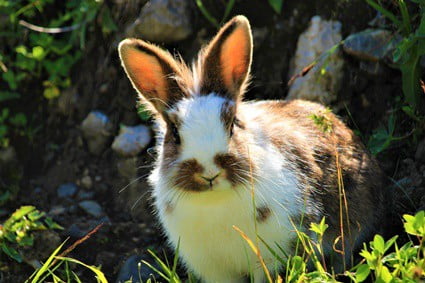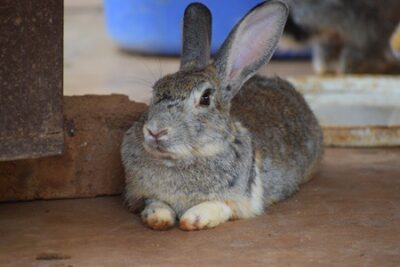There are some breeds of rabbits that are rarer than others. The scarcity of a rabbit breed can be due to many factors, all of them quickly fluctuating day by day. Thankfully, there are many organizations dedicated to following the breeds of rabbits that are threatened to extinction.
There are currently 17 rabbit breeds listed as a Conservation Priority Livestock Breed by the American Livestock Conservancy. These include the uniquely marked blanc de hotot, to the giant chinchilla. These breeds have a small population, despite their rich and varied histories.
If you’re looking to raise rabbits, rare breeds are something to consider. While you will most likely run into problems in terms of sourcing a rabbit, raising rare breeds can be a rewarding experience.
Rare Rabbit Breed List
Despite being bred for function, some rabbit breeds are more popular than others. There are many reasons for this phenomenon. Sometimes, some breeds are just easier to raise, while others could have had more advocacy behind them.
Whatever reason a breed doesn’t gain fame, all rabbit breeds have their own rich history, purpose, and unique traits. All of which make them deserving conservation and recognition.
Today, the American Rabbit Breeders Association recognizes 50 distinct breeds of rabbits. These range from the floppy-eared English Lop, to the Angora. However, some breeds have small populations.

Blanc De Hotot Rabbit
Originally developed in France, the blanc de hotot has a name that sounds as delicate as it looks. The blanc de hotot has a pure white coat, save for black bands around its eyes. These bands measure about 1/8 inch to 1/16 inch in diameter.
In terms of body shape, it is compact, rounded, and thickset. It has a thick outer layer of fur, creating a sheen that looks similar to frost. Despite its appearance, the Blanc de Hotot is an active and hardy breed, making it a great choice for breeders.
The first recognized blanc de hotot was produced in 1912 and became an officially recognized breed in 1922. They first specimens of the breed were immediately exported to the US, although the lack of popularity caused the breed to die out.
Efforts would again be made in 1978, with additional exports in 2004. At present, the blanc de hotot is listed as threatened by the American Livestock Breeds Conservancy, which means that there are currently less than 1,000 species of the breed in the world.
Silver Fox Rabbit
Known to be the third breed of rabbit developed in the U.S., the silver fox was first bred for meat and the interesting coloration of its fur.
It is named after the silver fox, which has a starkly similar fur coat in terms of texture and color. The silver fox rabbits have a solid black or blue coat, with fur that begins to silver at around 4 weeks old.
It is a dense coat, with hair about 1 ½ inches in length. When stroked from head to tail, the silver fox’s fur will stand straight, until it is stroked again in the opposite direction.
The silver fox is considered a threatened breed by the American Livestock Breeds Conservancy. Despite their low numbers, the silver fox population is bouncing back due to the renewed interest in its fur and meat.
Cinnamon Rabbit
Named after its interesting coloration, the cinnamon has the color of rust, or ground cinnamon. It has a smoky-grey coloring on its sides, with a darker color on its hind legs, feet, and face. Despite its popularity in competitive showing, the cinnamon is a rare breed because it was only recognized in the 1970s.
The cinnamon has an interesting origin as an ‘accidental’ creation of two children. Belle and Fred Houseman bred a chinchilla doe and New Zealand buck and were allowed to keep one buck from the litter, despite their father’s hesitation.
The children then bred the rabbit with two other breeds and found themselves with three russet-colored rabbits. They would eventually name these new rabbits ‘cinnamon.’
While the creation of the breed was nearly effortless, the Housemans’ struggled to have the breed officially recognized by the American Rabbit Breeder’s Association.
First, the rabbits contracted a virus on the way to a showing. On the way to another showing, the family was caught in a storm, and a dog broke into their rabbitry. Their perseverance did pay off when the Housemans finally had the breed officially recognized in 1972.
Lilac Rabbit
The standard for the lilac breed calls for a pinkish dove-grey color of its coat. Truly, the UK has a host of lilacs that pass the standard. In the U.S., however, the lilac has a dove-blue coat. While this coat is definitely unique, it does not pass the standard of the breed.
This may be one of the reasons why the breed never became popular in the US. Because of its lack of popularity, the Lilac is currently listed as a breed to watch by The American Livestock Breeds Conservancy. This indicates that the breed has less than 2,000 specimens globally and less than 200 registrations in the US every year.
Sable Marten Rabbit
The sable marten is a domestic rabbit breed, although their interesting coloration has earned them a spot in agricultural shows and pet shows. The sable marten weighs between 6.5 to 8.5 pounds fully grown, with fur that is soft and ‘polished.’
Aside from their fur, the sable marten is also known for being a great pet. They are a playful breed and are more timid than most rabbits of their size.
Like the cinnamon, the silver marten was created by accident in an attempt to improve the american chinchilla’s color and pattern. This eventually led to ‘little black rabbits’ among litters, as well as silver rabbits.
These rabbits would eventually be recognized as a separate breed in 1924. Currently, there are four recognized varieties of the sable marten, namely black, blue, chocolate, and sable.
Palomino Rabbit
The palomino gets its name from interesting origins. It began in 1910, when Mark Young began the breeding effort of a beige rabbit. In the 1950s, Young finally found the ideal beige rabbit, and called it the ‘american beige.’ Unhappy with the name, Young changed it to ‘washingtonian.’
Still unhappy with the name, Young would finally settle the choice during the 1952 convention of the American Rabbit Breeder’s Association. Right next to his rabbit cages, he placed a coffee can, and asked people to suggest names for the breed. And of course, the name that won was the palomino.
The palomino would officially be recognized as a separate rabbit breed in 1957. They are known to be a hardy breed, with beautiful fur colors that make them great for shows and as a pet.
There are two varieties of the breed. The original variety, the lynx, has a pearl-grey color with a diluted orange-beige. The lynx variety would follow soon after, with a bright golden color of its fur.
The palomino is currently on the watch list of the American Livestock Conservancy. There are believed to be less than 10,000 palominos in the world, with the golden variety more popular than the lynx.
Beveren Rabbit
Considered to be one of the oldest breeds of rabbits, beveren was first recognized in 1898. It was named after the town it originated from, namely Beveren, in Belgium. It was first exported to Britain in 1905 and was met with a lukewarm reception.
However, in May 1918, the Beveren Club was established, and the breed would go on to become one of the most popular fur breeds in the UK.
The breed was then imported into the U.S. in 1915. The breed had never caught on in popularity, even until today. But while their numbers remain low, there is still a chance for a boom in their popularity, much like the Beveren population in the UK.
The beveren has a dense and glossy coat, with long fur measuring 1 ¼ to 1 ½ inch. Their fur color can be solid blue, solid black, or white. Aside from their coat, the beveren is known for being a smart and clean rabbit that loves to explore.
Giant Chinchilla Rabbit
Since its creation, the chinchilla rabbit has been bred for its fur. When it first appeared in the U.S. in 1919, one man, Edward H. Stahl, knew that its popularity would be affected by the breed’s small size.
To address this, Stahl then set out to breed a ‘giant chinchilla.’ In 1921, he finally bred a doe of a size that he was happy about. Stahl named this first giant chinchilla ‘Million Dollar Princess.’
Like its name implies, the giant chinchilla weighs 12 pounds to 16 pounds. Because of their size, the giant chinchilla needs special accommodations.
Giant chinchillas should be kept in hutches with wooden floors and heavy beddings. Despite their size, giant chinchillas are known to be a gentle breed.
Checkered Giant Rabbit
The checkered giant takes its name from being one of the largest rabbit breeds in the world, as well as their distinct fur markings.
To be a recognized specimen of the breed, a checkered giant must have ‘butterfly’ shaped markings on its face, with the wings circling the nose and extending to the forehead. Because of these ‘butterfly’ markings, the breed is recognized as the ‘giant papillon’’ by the British Rabbit Council.
Checkered giants are considered a ‘running breed’, and require a lot of space to move in. Paired with their size, the checkered giant can become a cumbersome breed to manage. The American Livestock Conservancy currently lists the checkered giant as a threatened breed. This means that, on estimate, there are less than 5,000 checkered giants in the world.
Crème De Argent Rabbit
Recognized under the name argente crème by the British Rabbit Council, the crème argente has a cream white coat with an orange cast. It has a bright orange undercoat, which is also seen on its skin. They are considered large rabbits and can grow from 8 to 11 pounds.
The crème de argent takes its roots from France in the mid-to-late 1800s. It became popular due to its unique fur coloring and was bred to produce fur trimmings for the hats of the era.
The crème de argent was then exported to the US in 1924 and was bred for its meat. The crème de argent continues in popularity in the U.S. and UK until today because of its unique coloration.
Despite its popularity, the crème de argent is considered extinct in any other place on the globe. For this reason, the American Livestock Breeds Conservancy lists the crème de argent as a breed to watch.
Rabbits have a rich history, and rare breeds even more so. If you’re in the mind to raising rabbits, raising a rare breed can be a rewarding experience. Raising rabbits can be rewarding on its own, but raising rarer breeds lets you participate in continuing the history of these great breeds.

